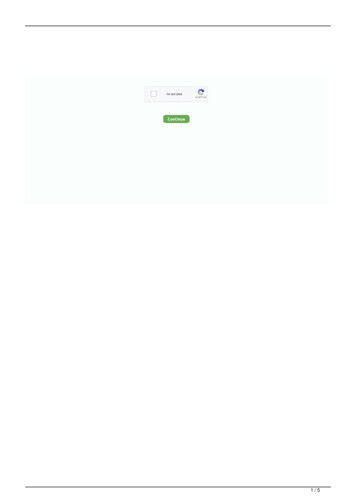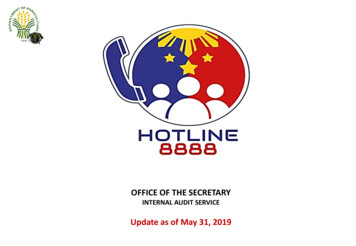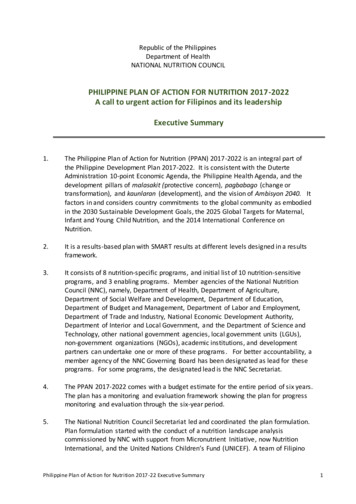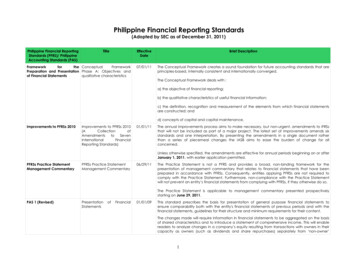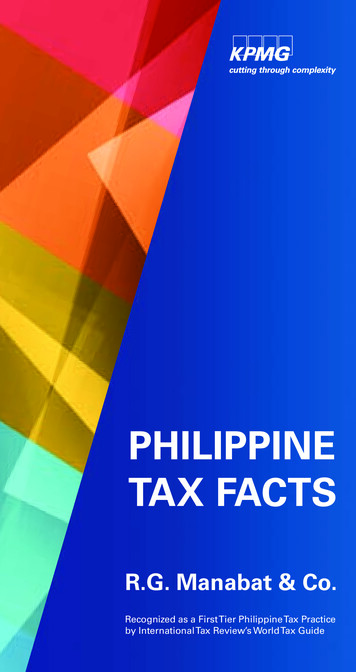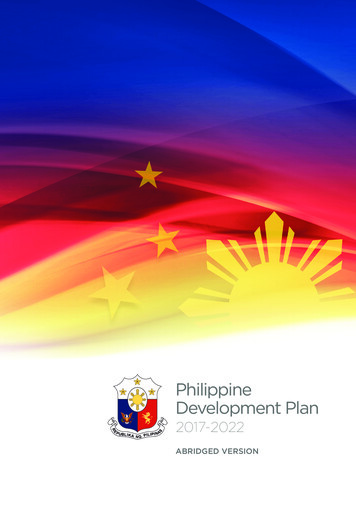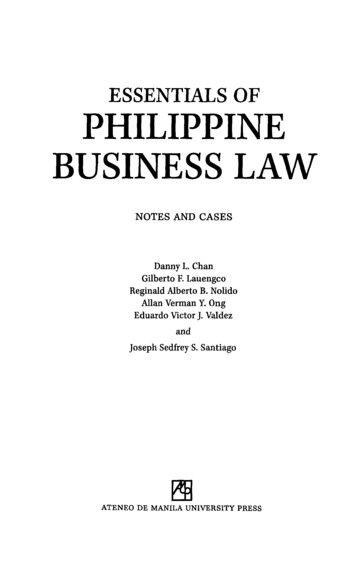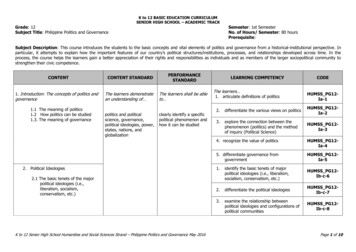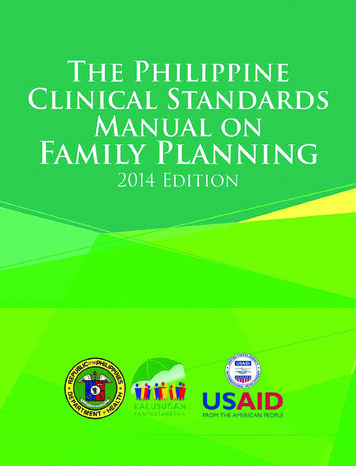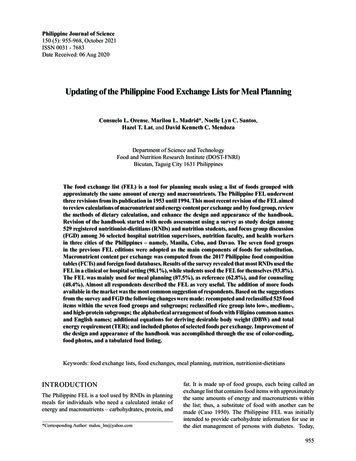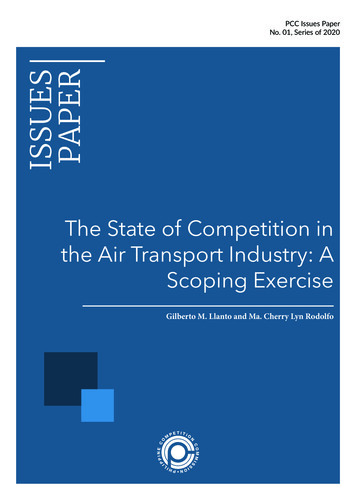
Transcription
ISSUESPAPERPCC Issues PaperNo. 01, Series of 2020The State of Competition inthe Air Transport Industry: AScoping ExerciseGilberto M. Llanto and Ma. Cherry Lyn Rodolfo
The State of Competition in the Air Transport Industry: A Scoping ExerciseThe State of Competition in the Air Transport Industry: A Scoping ExerciseGilberto M. Llanto and Ma. Cherry Lyn Rodolfo1Published by:Philippine Competition Commission25/F Vertis North Corporate Center 1North Avenue, Quezon City 1105PCC Issues Papers aim to examine the structure, conduct, and performance ofselect industries to better inform and guide PCC’s advocacy and enforcementinitiatives. The opinions, findings, conclusions, and recommendations expressedin these studies are those of the author(s) and do not necessarily reflect the viewsof the Commission. This work is protected by copyright and should be citedaccordingly.The views reflected in this paper shall not in any way restrict or confine the abilityof the PCC to carry out its duties and functions, as set out in the PhilippineCompetition Act. PCC reserves the right, when examining any alleged anticompetitive activity that may come to its attention, to carry out its own marketdefinition exercise and/or competition assessment, in a manner which may deviateor differ from the views expressed in this paper.1 The authors gratefully acknowledge the inputs of Irish Almeida in the section on policy and regulatory framework, the assistance of Ma.Kristina Ortiz with data and preparation of charts/figures, and of Paolo Tejano and Cara Latinazo, both of the Philippine CompetitionCommission in arranging and participating in meetings with various industry stakeholders. The authors would like to thank participants fortheir comments and suggestions on the initial draft of the paper during a presentation at the Philippine Competition Commission on August1, 2018. Likewise, we acknowledge the invaluable inputs provided by individuals whom we interviewed in preparing this paper. queries@phcc.gov.ph www.facebook.com/CompetitionPH www.twitter.com/CompetitionPH www.phcc.gov.phI. INTRODUCTIONpolicies which relate to (i) the opening upof regional airports to international flights,(ii) reciprocity as to whether it hinderspenetration of regional airports by foreigncarriers; and (iii) the overall air transportpolicy objective of the government, willremain unaddressed. Despite this limitation,the report tries to provide a substantialanalysis of the present situation of theindustry and the competition-relatedissues faced by the industry, the public andgovernment.This study reviews the state of competitionin the domestic air transport industry,specifically focusing on the airlinepassenger business. In reviewing thebusiness and economic landscape ofthe industry, it considers factors such asthe market structure of the domestic airtransport industry, the economic incentives2that motivate the airline companies tobehave in a certain way, and the regulations3affecting the industry. The study turns toWilliamson’s (1975) idea that organizationsreview organizational costs and configuresa governance structure that minimizes costsand maximizes revenues subject to theconstraints of extant policy and regulatoryframework. Because the airline transportindustry is a complex mix of a competitiveand regulated industry, it is important todetermine how government regulationsaffect the level of competition in the industry(Gowrisankaran, 2002).After a brief introduction, Section 2 presentsan overview of the air transport industryand uses an aviation services market valuechain as a neat frame for understanding howseveral entities collaborate and coordinatein producing the air transport servicesconsumed by the buyer (passenger/cargoowner/shipper). A complete understandingof competition and competition-relatedissues in the air transport industry requiresa study of the various components ofthe value chain. In this study, two suchcomponents, namely, airlines (main serviceprovider) and the airports (a critical fixedasset in the production process) areconsidered. Section 3 summarizes theperformance of the air transport industryafter initial liberalization and deregulationefforts in the industry as gleaned fromavailable literature. Section 4 discussespolicy and regulations in the air transportindustry and an initial review of air servicesagreement entered into by the country inorder to identify potential barriers to a morecompetitive air transport market. Section5 discusses the present situation in theair transport industry. Section 6 discussesthe important role of airports in the airtransport market with a focus on physicalinfrastructure and slot allocation. Thefinal section summarizes our findings andprovides some recommendations.This study is a scoping exercise. It providesbroad strokes of the current situation inthe industry, including an assessment ofthe role of airports, more specifically theNinoy Aquino International Airport (NAIA),in air transport service delivery; identifiespotential anticompetition issues; andsubmits some recommendations for furtherdetailed study.At the outset, it is important to note theimportance of getting cooperation fromconcerned government agencies and theindustry players in the conduct of this study.The report does not have any information onthe operations of Clark International Airport.At this point, it will be difficult to give ameaningful answer to the question to whatextent does Clark impose a competitiveconstraint on NAIA? We were also unable tomeet with the Department of Transportationand the Civil Aviation Authority of thePhilippines (CAAP) to discuss air transportpolicy, regulation and planning. Thus, thesuggestion to include an assessment on the2 Defined as whatever motivates behavior in a certain way in contrast to preferences, that is ‘wants’, ‘needs’. es-definition-examples-quiz.html (accessed January 6, 2018).3 The Civil Aeronautics Board (CAB) is tasked with economic regulation while the Civil Aviation Authority of the Philippines (CAAP) is chargedwith regulation of technical and safety aspects of the industry.1
The State of Competition in the Air Transport Industry: A Scoping ExerciseII. THE IMPORTANCE OF THE AIRTRANSPORT INDUSTRYBox 1. The economic impacts of thePhilippine air transport industryThe air transport industry provides thecountry with vital connectivity within themajor islands of the archipelago and tothe outside world. A well-functioning airtransport industry correlates positively witha high level of growth (Perovic, 2013) andimpacts the economy through growth intourism, trade, investments, employment,and productivity (Rodolfo, 2017). Themajor purchasers of air transportationservices are high value industries, indicatingthe air transport industry’s importantlinkage to other sectors of the economy.Based on the Input-Output Tables of thePhilippines, the wholesale and retail tradeindustry is the largest purchaser of airtransportation services with 21.5 percent ofall industry spending on aviation services.Telecommunications spending for aviationservices was at 8.3 percent of all industryspending on aviation services (InterVistas,2015).4 In 2014, Oxford Economics (2016)estimated foreign tourists spending in thePhilippines at US 4.7 billion; in addition, thePhilippines exported US 82.2 billion worthof goods and services. Box 1 summarizesan estimate of the economic impacts of thePhilippine air transport industry.The State of Competition in the Air Transport Industry: A Scoping ExerciseFigure 2.1 Aviation services market value chainIn 2017, the Philippine air transport industry directlygenerated Php 32.7 billion of gross value added(GVA) in real terms, equivalent to 12.4% of the GVAof the transportation and storage sector, and 0.21%of GDP. Among the transportation industries, airtransport ranked second to land transport in termsof GVA contribution. IATA (2016) reported that theair transport’s share to Philippine GDP in 2014 wasroughly 3.5% due to its direct, indirect, induced andcatalytic effects. The Philippine air transport industrysupported 1.4 million jobs including 69,800 direct airjobs and 1.2 million jobs from the wider economicbenefits- tourism, productivity and trade. By 2035, theindustry is expected to generate 3.4 million jobs andcontribute US 23 billion to Philippine GDP.Air transport is a vital support to the tourism industry.In 2017, the Philippine Statistics Authority, drawingfrom the Philippine Tourism Satellite Accounts,reported that the industry contributed Php 1.93 trillionto the Philippine economy, equivalent to 12.2% ofGDP. The employment in tourism accounted for 13.1%of national employment. Air transport moved 99%of the 6.6 million international tourists who spentPhp 448.6 billion during their stay in the country.Adding airline receipts amounting to an estimatedPhp 68.6 billion, international tourism ranked as the4th largest export revenue earner of the Philippines,next to electronics and semi-conductors, overseasremittances, and information technology and businessprocess management. While the share to total tradevolume is a meager 0.5%, air transport moved atleast 52.5% of the dollar value of merchandisetrade shipments in 2017. Air transport supportedthe mobility of overseas Filipino workers and theirfamilies, who contributed around US 28 billion to theeconomy in 2017.The aviation services value chain shown inFigure 2.1 provides a neat starting point forunderstanding the air transport industry.The end-product is the service delivered astransport of passengers and/or cargo fromdesignated points of origin to their pointsof destination. The passengers or cargoshippers/forwarders/owners are the buyers(customers) of the product. The airlinesare the major service delivery units in thevalue chain and to efficiently accomplishthe service delivery task various other unitsin the chain such as airport infrastructureand communications, should also efficientlyperform their important roles in the chain.In terms of multiplier effects, based on the 2006Input-Output Tables of the Philippine StatisticsAuthority, every peso increase in the final demand byconsumers, government or shippers for air transportservices translates to an additional Php 2.49 to thePhilippine economy.Source: Rodolfo (2017) as updated by the authorsintricate exploitation of connectedness ofmarketing and sales (e.g., computer/centralreservations systems, travel agents), inboundand outbound logistics (e.g., aircraftmanufacturers, air carriers), supportingoperations (e.g., ground handlers, airportinfrastructure), and even financing in thecase of airlines entering into long-termleases of aircrafts, in order to deliver theproduct or service (air transport from pointsof origin to points of destination).5The component units of the value chainhave to coordinate and perform wellto deliver the product. It involves an4 Source of basic data http://www.nscb.gov.ph/io/DataCharts.asp5 Michael Porter’s value chain analysis considered inbound and outbound logistics, operations, marketing and sales, and service as primaryactivities of the value chain. See Porter (1985).2Source: Tretheway and Markhvida (2014)This study reviews the performanceof airlines and airport infrastructure inservice delivery. It does not include othercomponents of the value chain, such asproviders of insurance, ground services,catering, aircraft maintenance services. Theairlines included in this study are PhilippineAirlines, Cebu Pacific, and Air Asia. Minorairlines are mentioned in passing. Thestudy includes a discussion of operationsat the NAIA in Pasay City, Metro Manila. Thelearning derived from the case study of theoperation of airlines in NAIA could be usedas a take off point for future in-depth studiesof airline and airport operation in other partsof the country, specifically Cebu and Davaointernational airports, or such airports to beidentified by the Philippine CompetitionCommission (PCC).and time constraints. An in-depth lookat the air transport market for cargo (i.e.,freight forwarders, cargo integrators, andconsolidators) may be undertaken by thePCC in the future. Similarly, an assessmentof the role of computer reservation systems(CRS), travel agents, integrators, and touroperators in the domestic air transportindustry may be considered.There could be a need for a future studyof the other components or units of theair services market value chain to get acomplete understanding of competitionissues in the air transport industry. Certainpractices in the air transport industry couldgive rise to competition issues. We onlydescribe in passing some of these practicesbecause they are outside the scope of thisstudy but certainly they are important areasfor future study.Figure 2.1 also shows that airlines have tocollaborate with two types of distributionsystems, one for passengers and the otherfor freight, in accomplishing their servicedelivery task. Cargo services are importantto the extent that they compete withpassenger flights for take-off and landingrights and gate use. Cargo services arenot included in the study for lack of dataOne of those practices is the code-sharingarrangements among airlines that allowa flight operated by one carrier (knownas the “operating carrier” which will offerthe flight for sale under its own code ordesignator and associated flight number) tobe marketed by another carrier (known as3
The State of Competition in the Air Transport Industry: A Scoping Exercisethe “marketing carrier”) under the operatingcarrier’s code and flight number. Cleave(2007) points out that these agreementscan lead to different outcomes dependingon market conditions and the nature of thecode shares (i.e., parallel, unilateral, beyondor behind). While agreements amongpartner airlines that have complementarynetworks benefit consumers, they alsohave the potential to increase entrybarriers in congested airports, resultingto disadvantages to passengers. Thus, thepractice may favor collusive behaviorsamong airlines by enabling the exchangeof commercially sensitive information andengendering all the typical downsidesstemming from cooperation amongcompetitors (European CompetitionAuthorities, 2006).airline within the same alliance may alsoconstitute a considerable entry barrier.Hanlon (1996) pointed out that more thanhalf of respondents (travelers) in his surveyalways or almost always considered buildingFFP mileage in their choice of airlines.The FFPs build loyalty among customersin favor of incumbents who can also linethose FFPs with additional perks. The FFPstend to affect competition by increasingcustomer switching costs, thus, reducingchances of competitors to attract customersfrom airlines offering FFPs. Apart fromstrong loyalty effects, the loyalty programsmay tend to reduce effective or potentialcompetition if they have the so called tyingeffects,7 foreclosure effects,8 and strongexclusivity effects9 (European CompetitionAuthorities, 2005).Some code shares involve interliningarrangement,6 whereby an airline enters intoan agreement with another airline to carrypassengers on behalf of another airlineAustria (2001) made the point that thistype of arrangement becomes “particularlyimportant and strategic if an airline hasextensive domestic network or if one of thepoints in the route is an international hub”.Typically, an incumbent airline, which hasfirst-mover advantage, would have had suchinterlining arrangement done in the past.Potential new entrants to the air transportmarket without such interlining or codesharing arrangement may face difficulty inattracting passengers who are ready to payfor interline travel because of greater seatavailability and greater flight frequencies,including greater amenities (e.g., travellounge available to business and first-classtravelers) provided by airlines who havea history of code-sharing or interliningarrangement.The CRS also has the potential to directpassengers to the airline who owns orcontrols it. The CRS, which was a devicedeveloped to save time and effort inhandling numerous flight reservationsduring the era of regulated airfares, hasbeen transformed into an instrument forgiving priority screen listing to incumbentcarriers’ flights or to whoever owns ordirects such CRS (Hanlon 1996, Warren et al,1999, Austria 2001). Hanlon (1996) observedthat 75 percent of flights made through aCRS are made from the first screen page ofthe CRS. It will be interesting to find out ifthe same phenomenon can be seen in thedomestic air transport market.III. COMPETITION AND REGULATORYISSUES IDENTIFIED IN THELITERATUREThe airline industry has many uniquefeatures. As listed by Vasigh, Fleming,and Tacker (2008) they are as follows:(a) perishable nature of the product andthe consequent elasticity of demand andpricing complications; (b) the control ofthe method of delivering the service byAnother feature of the air transport industrythat may act as an entry barrier is thefrequent flyer programs (FFP) offered byincumbent carriers. The pooling of FFPs by6 Interlining agreements do not necessarily involve code-sharing.7 If the tying is not objectively justified by the nature of the products or commercial usage, such practice may constitute an abuse of adominant position.8 A foreclosure effect arises from agreements, which are capable of affecting patterns of trade making it more difficult for undertakings topenetrate a market. It may occur when suppliers impose exclusive purchasing obligation on buyers.9 When most or all of the suppliers apply exclusive customer allocation, this may facilitate collusion, both at the suppliers’ and the distributors’level. Hence, a competition risk of exclusive supply is the foreclosure of other buyers4The State of Competition in the Air Transport Industry: A Scoping Exercisea disinterested third party (namely, airtraffic control); (c) the presence of only twomajor suppliers of the means of providingthe service; (d) the unique dominance ofthis form of transportation for long haulpassenger traffic; (e) the interesting andcomplicated financial arrangements that areused to provide the service; (f) the existenceof quasimonopolistic entities (airports) tojointly deliver the service; and (g) last, butby no means least, the international legalaspects of the industry. It is a complexand important transport industry and fromthe point of view of competition policy,its industrial organization gives rise tocompetition issues.several carriers reduced the number ofdepartures and seat capacity thus resultingin cabin congestion. The liberalizationof international and regional routes alsoresulted in substantial reductions in airfareas the number of competitors increasedbut with the side effect of reducing profitsfor most airlines. Citing various studies,Manuela (2011) reported that low-costcarriers (LCCs) are the major beneficiariesof deregulation and liberalization, andby offering lower fares and keeping theircosts at a minimum those LCCs flourishedat a time when their larger rivals havebeen in and out of Chapter 11 bankruptcyprotection. He cited the findings of severalstudies indicating that: (i) competitionbetween full service airlines and LCCsresulted in price wars, driving weakerairlines into bankruptcy, (ii) airlines usedprice discrimination to keep their marketshare and increase revenues and profits;and (iii) price discrimination can increase theairlines’ profits by selling tickets at differentprices and restrictions, taking advantage ofthe different price elasticities of demand ofcustomers.Studies on the performance of the airtransport industry will invariably haveas a useful reference the experience ofthe United States with deregulation andliberalization, which intensified competitionin the industry. Manuela’s (2011) review ofliterature described the US experience. Hissummary is as follows.10 The deregulationof the domestic airline industry in theUS in 1978 was the forerunner of similarpolicy shifts across the Atlantic and in otherdeveloped economies. Deregulation, incombination with competition, spurredgrowth in the airline industry and resultedin lower fares, more efficient use of capital,higher productivity, more passengers, andmore departures. One of the downsides ofderegulation, however, is more crowdedplanes and congested airports becauseof the tremendous growth in passengertraffic in the US between 1979 and 2002,which outpaced the growth in capacityas new entrants and weaker airlines filedfor bankruptcy or were acquired by theirlarger rivals. More crowded airplanes andcongested airports tend to reduce theairlines’ quality of service especially in highdensity markets.In the US, Vasigh, Fleming, and Tacker(2008) observed some initial problemswith deregulation in 1979 but eventuallythe airline industry was able to recover andposted profits in the late 1980s and againin the late 1990s. Airlines were forced toinnovate and control costs in response tothe competition. Some innovations weremore effective revenue management,FFPs, and recently e-ticketing, whichallows airlines to reduce ticket distributioncosts. Technological innovations that havegiven rise to better and more fuel-efficientjet engines helped with increasing theprofitability of the airlines. The recoveryof the global economy at that time alsohelped to put the industry in the black. Thus,deregulation led to a lowering of airfareswith the consequent air traffic growth. Thefreedom of airlines to determine their routesresulted in more flight frequencies and nonstop flights.Manuela (2011) referring to various studiesreported that the US deregulation benefitedmany passengers, but due to intensecompetition a number of incumbents andnew entrants exited the air transport industrya few years after deregulation. The exit of10 Manuela’s review of literature cited various authors who did studies on the various aspects of the US experience with liberalization andderegulation.5
The State of Competition in the Air Transport Industry: A Scoping ExerciseVasigh, Fleming, and Tacker (2008further noted that the recent air transportliberalization in Europe and India has led toa tremendous growth in air traffic in thesecountries. On the other hand, in the US, theinternational routes have been deregulatedonly gradually through negotiated bilateralopen-skies agreements. These agreementsenable airlines from two countries (bilateralpartners) to fly between their respectivecountries without restrictions. Nevertheless,limited open-skies agreements do notnecessarily create a fully competitive market(Gowrisankaran, 2002)of which was Cebu Pacific. Grand Airentered the domestic air transport industryin 1995 while Air Philippines, Asian Spirit,and Cebu Pacific Air (Cebu Pac) enteredin 1996. Asian Spirit and Air Philippineschanged their names to Zest Airways (Zest)in 2008 and Airphil Express (Airphil) in 2009,respectively. Grand Air exited the industryin late 1998 while South East Asian Airlines(SEAir), a charter operator, entered thescheduled airline industry in 2003, bringingthe number of active airlines to five, namelyPAL, Cebu Pac, Zest, Airphil, and SEAair.EO No. 219 relaxed market entry andencouraged at least two airline operators inany route while exit from unprofitable routeswas given free course.In the Philippines, the year 1995 markeda critical turning point in the domestic airtransport industry (used interchangeablyhere with “civil aviation industry”) with theissuance of Executive Order (EO) No. 219liberalizing the industry.11 This included theprivatization of Philippine Airlines (PAL).12For more than 20 years before the issuanceof EO No. 219, the air transport industrywas a monopoly of PAL, a corporation fullyowned and controlled by the government.13Letters of Instructions Nos. 151 and 151-Aissued in 1973 granted PAL a monopolyof the civil aviation industry. AlthoughPresidential Decree 1590 (issued in 1987)provided PAL with a franchise, which wasnot considered as an exclusive privilege toPAL, it nevertheless operated as a virtualmonopoly from 1973 till the issuance of EONo. 219 in 1995. Before liberalization andderegulation under EO No. 219, the CivilAeronautics Board determined which routesthe PAL, a monopoly, will service, and at thesame time regulated air ticket prices.14At present, PAL, Cebu Pac, Airphil, and tosome extent Air Asia (a new operator), servethe major high-density markets while minorroutes were left to the small operators likeZest, SEAir, and Skyjet. It is noted that PALHoldings own Airphil, which has a codeshare agreement with PAL.In 2014, SEAir, Inc. was acquired by CebuPacific and was rebranded as “CebGo.”CebGo now operates an all ATR-fleet servinginter-island short routes. Cebu Pacific andits wholly-owned subsidiary CebGo nowcomprise the Cebu Pacific Group (CEB),which is today the largest Philippine carrierin terms of routes and frequencies operatedwithin the Philippines.15There was an increase in the number ofpassenger seats offered in major marketssuch as Manila-Iloilo, Manila-Cagayan deOro, and Manila-Bacolod. The expansionof passenger seats in the major markets,e.g., Manila-Bacolod market expandingby as much as 42 percent between 1994and 1995 even without the presence of acompetitor, was interpreted as an indicationthat PAL had been restricting outputprior to liberalization (in 1995) and thatLiberalization and deregulation stimulatedthe growth of the domestic civil aviationindustry. After the removal of restrictions onroutes, flight frequencies, and fare setting,domestic airline passenger traffic grew withthe entry of several competitor airlines inthe civil aviation industry, the most notable11 This section of the study draws from Austria (2001) and Manuela (2011).12 The first domestic airline was PAL, a government owned-and-controlled corporation, which served as the flagcarrier of the country. This wasbefore the issuance of EO No. 219.13 Inefficient management and financial woes eventually led to the privatization of PAL. It was dependent on government subsidies for itsoperations. Austria (2001) described the mismanagement of PAL and its inefficient air services as a clear waste of resources.14 This was the same situation in the US before deregulation in 1979 when the US Civil Aeronautics Board controlled airline routes and pricing(Gowrisankaran, 2002).15 Source: Cebu Pacific position paper on House Bill Nos. 5815 and 5817 submitted to the Committee on Legislative Franchises, House ofRepresentatives, August 10, 2017.6The State of Competition in the Air Transport Industry: A Scoping Exercisesuch restriction of passenger seats belowcompetitive levels had resulted in efficiencylosses,16 which in turn had an adverseimpact on consumers. By 2009, Manuela(2011) indicated that PAL, CEB, Airphil,Zest, and, SEAir competed for almost14.7 million domestic passengers, up 198percent from its 1995 level, outpacing thegrowth in capacity or passenger seats, whichincreased 176 percent in the same period.The load factor then is higher in 2009 than in1995, a positive development in an industrycharacterized by losses and bankruptcies.Fare setting in markets with at least twoairline operators was deregulated underEO No. 219 although fares in markets with asingle operator continued to be regulated.Manuela (2006) estimated that airfare perkilometer is 10 percent lower, on average,after liberalization while more than 90percent of domestic airline passengersin 2003 benefited from lower fares dueto discounts and promos that stimulateddemand for air transport services.17years after liberalization. Austria (2001)also mentioned the short-lived operationof Mindanao Express, an airline intendedto serve regional routes. Manuela (2011)pointed out that in 1999 PAL pulled awayfrom low-density markets and concentratedon the most profitable routes to stay incompetition. Both major airlines like PALand smaller airlines in the scheduled airlineindustry suffered substantial losses duringthis period because of those external events(see Table 3.1). Thus, even major operatorslike PAL,which has a sizeable share of themarket are not immune to downturns andlosses arising fromsuch external events.It can be recalled that European airlinesand the global travel industry sufferedsubstantial losses during the height of theSevere Acute Respiratory Syndrome (SARS)crisis.18Despite the erosion of PAL’s share of themarket in terms of passenger and cargotraffic, number of passenger seats, andrevenues, it has managed to retain asubstantial share of the market. Austria’s(2001) computation of the HerfindahlHirschman Index (HHI) for the industry, ameasure of industry concentration, showsit is only the major routes that are fiercelycontested. She noted that the secondaryand tertiary or the minor routes were nichemarkets,which faced competition from thenascent high speed ferries that started tooperate following the deregulation of theinter-island shipping industry. The HHI isa measure of industry concentration; avalue of 1 corresponds to a monopoly; 0.5corresponds to an industry with two equalsized firms, 0.33 to an industry with threeequal-sized firms, etc. (Gowrisankaran,2002).The immediate results of liberalization,therefore, were the entry of severaloperators as well as the huge increase indomestic passenger traffic in traditionalmajor markets and the opening of newmarkets for airline services. An example ofa relatively new market is Caticlan, whichhas become an important gateway to theworld-famous Boracay island, a major touristdestination.It has been observed that the airline industryis vulnerable to economic fluctuations andis inherently unstable (Gowrisankaran, 2002;Manuela, 2011) with volatility in prices offuel and labor contributing to fluctuationsin profitability. The Asian financial crisis andlately the global economic crisis, threatsof terrorism, and a general slowdown ofeconomies have had adverse impacts onregional and global airli
5 Michael Porter's value chain analysis considered inbound and outbound logistics, operations, marketing and sales, and service as primary activities of the value chain. See Porter (1985). intricate exploitation of connectedness of marketing and sales (e.g., computer/central reservations systems, travel agents), inbound
